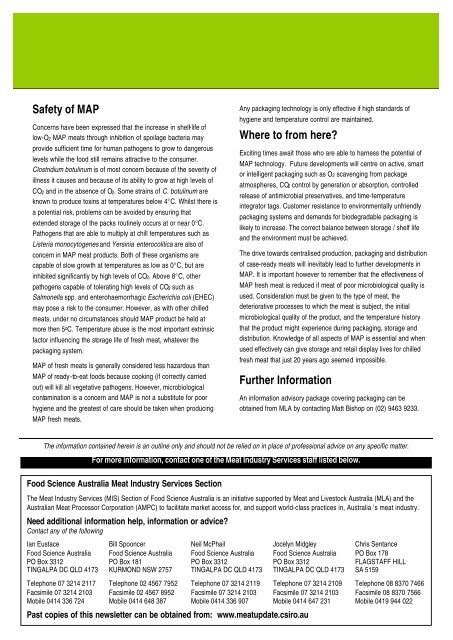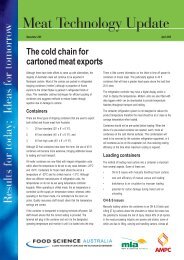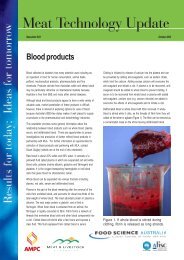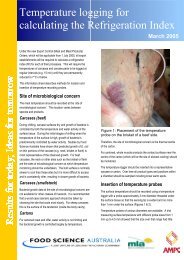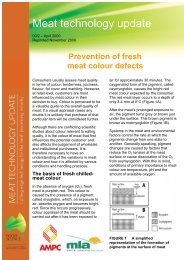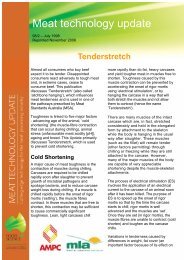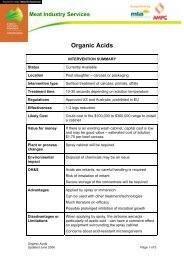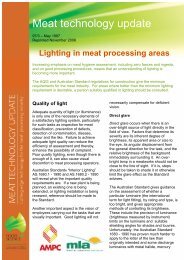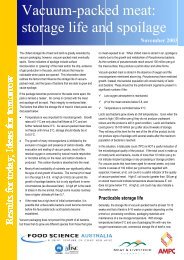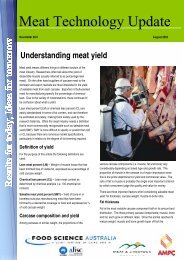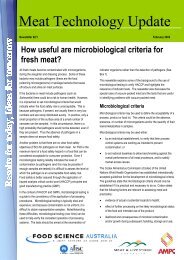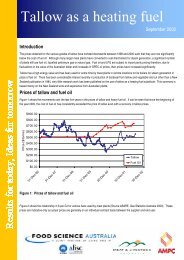Modified atmosphere packaging of meat. - Meat Industry Services
Modified atmosphere packaging of meat. - Meat Industry Services
Modified atmosphere packaging of meat. - Meat Industry Services
Create successful ePaper yourself
Turn your PDF publications into a flip-book with our unique Google optimized e-Paper software.
Safety <strong>of</strong> MAPConcerns have been expressed that the increase in shelf-life <strong>of</strong>low-O2 MAP <strong>meat</strong>s through inhibition <strong>of</strong> spoilage bacteria mayprovide sufficient time for human pathogens to grow to dangerouslevels while the food still remains attractive to the consumer.Clostridium botulinum is <strong>of</strong> most concern because <strong>of</strong> the severity <strong>of</strong>illness it causes and because <strong>of</strong> its ability to grow at high levels <strong>of</strong>CO2 and in the absence <strong>of</strong> O2. Some strains <strong>of</strong> C. botulinum areknown to produce toxins at temperatures below 4°C. Whilst there isa potential risk, problems can be avoided by ensuring thatextended storage <strong>of</strong> the packs routinely occurs at or near 0°C.Pathogens that are able to multiply at chill temperatures such asListeria monocytogenes and Yersinia enterocolitica are also <strong>of</strong>concern in MAP <strong>meat</strong> products. Both <strong>of</strong> these organisms arecapable <strong>of</strong> slow growth at temperatures as low as 0°C, but areinhibited significantly by high levels <strong>of</strong> CO2. Above 8°C, otherpathogens capable <strong>of</strong> tolerating high levels <strong>of</strong> CO2 such asSalmonella spp. and enterohaemorrhagic Escherichia coli (EHEC)may pose a risk to the consumer. However, as with other chilled<strong>meat</strong>s, under no circumstances should MAP product be held atmore then 5 o C. Temperature abuse is the most important extrinsicfactor influencing the storage life <strong>of</strong> fresh <strong>meat</strong>, whatever the<strong>packaging</strong> system.MAP <strong>of</strong> fresh <strong>meat</strong>s is generally considered less hazardous thanMAP <strong>of</strong> ready-to-eat foods because cooking (if correctly carriedout) will kill all vegetative pathogens. However, microbiologicalcontamination is a concern and MAP is not a substitute for poorhygiene and the greatest <strong>of</strong> care should be taken when producingMAP fresh <strong>meat</strong>s.Any <strong>packaging</strong> technology is only effective if high standards <strong>of</strong>hygiene and temperature control are maintained.Where to from here?Exciting times await those who are able to harness the potential <strong>of</strong>MAP technology. Future developments will centre on active, smartor intelligent <strong>packaging</strong> such as O2 scavenging from package<strong>atmosphere</strong>s, CO2 control by generation or absorption, controlledrelease <strong>of</strong> antimicrobial preservatives, and time-temperatureintegrator tags. Customer resistance to environmentally unfriendly<strong>packaging</strong> systems and demands for biodegradable <strong>packaging</strong> islikely to increase. The correct balance between storage / shelf lifeand the environment must be achieved.The drive towards centralised production, <strong>packaging</strong> and distribution<strong>of</strong> case-ready <strong>meat</strong>s will inevitably lead to further developments inMAP. It is important however to remember that the effectiveness <strong>of</strong>MAP fresh <strong>meat</strong> is reduced if <strong>meat</strong> <strong>of</strong> poor microbiological quality isused. Consideration must be given to the type <strong>of</strong> <strong>meat</strong>, thedeteriorative processes to which the <strong>meat</strong> is subject, the initialmicrobiological quality <strong>of</strong> the product, and the temperature historythat the product might experience during <strong>packaging</strong>, storage anddistribution. Knowledge <strong>of</strong> all aspects <strong>of</strong> MAP is essential and whenused effectively can give storage and retail display lives for chilledfresh <strong>meat</strong> that just 20 years ago seemed impossible.Further InformationAn information advisory package covering <strong>packaging</strong> can beobtained from MLA by contacting Matt Bishop on (02) 9463 9233.The information contained herein is an outline only and should not be relied on in place <strong>of</strong> pr<strong>of</strong>essional advice on any specific matter.For more information, contact one <strong>of</strong> the <strong>Meat</strong> <strong>Industry</strong> <strong>Services</strong> staff listed below.Food Science Australia <strong>Meat</strong> <strong>Industry</strong> <strong>Services</strong> SectionThe <strong>Meat</strong> <strong>Industry</strong> <strong>Services</strong> (MIS) Section <strong>of</strong> Food Science Australia is an initiative supported by <strong>Meat</strong> and Livestock Australia (MLA) and theAustralian <strong>Meat</strong> Processor Corporation (AMPC) to facilitate market access for, and support world-class practices in, Australia ’s <strong>meat</strong> industry.Need additional information help, information or advice?Contact any <strong>of</strong> the followingIan Eustace Bill Spooncer Neil McPhail Jocelyn Midgley Chris SentanceFood Science Australia Food Science Australia Food Science Australia Food Science Australia PO Box 178PO Box 3312 PO Box 181 PO Box 3312 PO Box 3312 FLAGSTAFF HILLTINGALPA DC QLD 4173 KURMOND NSW 2757 TINGALPA DC QLD 4173 TINGALPA DC QLD 4173 SA 5159Telephone 07 3214 2117 Telephone 02 4567 7952 Telephone 07 3214 2119 Telephone 07 3214 2109 Telephone 08 8370 7466Facsimile 07 3214 2103 Facsimile 02 4567 8952 Facsimile 07 3214 2103 Facsimile 07 3214 2103 Facsimile 08 8370 7566Mobile 0414 336 724 Mobile 0414 648 387 Mobile 0414 336 907 Mobile 0414 647 231 Mobile 0419 944 022Past copies <strong>of</strong> this newsletter can be obtained from: www.<strong>meat</strong>update.csiro.au


